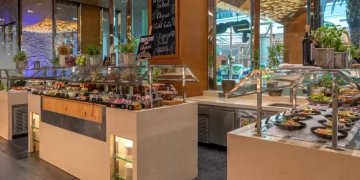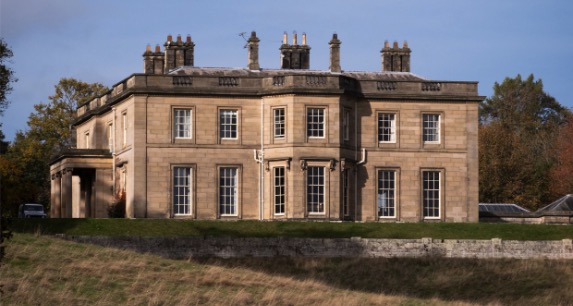The English country house has chameleon-like qualities. It can change and adapt its colouration through successive generations of owners, shifts of taste and government, and fluctuations of income. Some houses hit the buffers, to be reincarnated as hotels, boarding schools and borstals. Many more were demolished during the last century. But those that have retained the layers and richness of their inheritance are ingrained with a special character, miraculously preserved as if in aspic.

Such is the story of Meldon Park, described by one country-house writer as being one of the “illustrious obscure”. It is a handsome, four-square pile in golden brown sandstone, standing on a 3,800-acre estate in Northumberland, with an austere neoclassical façade that is much admired by architectural historians.
Meldon was built for Isaac Cookson in 1832 by John Dobson, a successful local architect. Dobson was a close friend of Robert Smirke and his eponymous son, the builder of the British Museum, and his rigorous approach to mass and scale reflects similar taste. His clients, the Cookson family, were wealthy merchants who prospered from establishing a local glass and chemical works. As a result, Isaac Cookson could glaze his new house with the huge windows that grace the main rooms on the south and east sides. Mark Girouard described Meldon’s large, bright, airy rooms as representing “the last flowering of the Georgian country-house tradition”, before the Victorians turned instead to crepuscular gloom and shade.
Meldon has comparatively small rooms, a sizeable service wing and a handsome Orangery, another feat of glazing from the Cookson’s glassworks. Its contents, to be offered in the Collections Sale in Edinburgh in February, are a delicious and archetypal set of country-house furnishings of the best periods, reflecting the house’s long tenure by a single family. The Cooksons held on for seven generations, making way only for an evacuated children’s orthopaedic hospital during World War II and, in the 1960s, selling some of its collection of Old Master paintings.
The chattels and furnishings that Meldon contains were made, bought or commissioned for the house. They include a superb dusky pink Ushak carpet that fills the preposterously grand entrance hall, patterned with geometric medallions in a trellis of lozenges. Above it rises a central staircase of imperial proportions, an astonishing coup d’oeil, the sibling of those in the Pall Mall gentlemen’s clubs and, indeed, the British Museum. Its wrought-iron balustrades were later exchanged for mahogany by Edwin Lutyens, who also added plaster medallions to soften Dobson’s more austere style.
The 17th-century oak refectory table that stands against a wall here, loaded with a cargo of Chinese porcelain, may well have come from the earlier great house at Meldon, during its occupancy by Sir William Fenwick and his alarming wife Meg of Meldon, a notorious local witch. Her ghost was said to run, as a small black dog, along the parapet of the bridge over the River Wansbeck below the present house. She appeared so frequently that local people became quite blasé about her hauntings. The pair of 18th-century needlework banners worked with the royal coat of arms may well have done earlier service in a side aisle of the local church, where Sir William Fenwick’s effigy lies slumbering by the font.
The drawing and dining rooms of country houses like this one were poles around which the social functions of the household revolved. Music and entertaining, tea and coffee rituals took place in one, and formal meals and strong potations were taken in the other. Drawing rooms traditionally received the best of the fine art and ornaments: Meldon’s drawing room walls are hung with some of the best pictures remaining from an Old Master collection that has been here for almost 200 years.
Either side of the chimneypiece hang an almost-matching pair of limpid landscapes, a Mediterranean harbour view after Claude Lorrain and its partner, Dido and Alexandra, painted by the British artist John Wilson Ewbank at the start of the 19th century. They are typical of that century’s love affair with classical Italy and its mythologies. A three-seater mahogany framed Knole-type sofa by Howard & Sons Ltd – much the most comfortable-looking piece of seat furniture in the room – is modestly estimated at £1,000-1,500. The chimney garniture consists of a mantel clock, by the Parisian maker Rennison, set off by a sparkling pair of Victorian glass lustre vases.
The historical pastimes of country-house life are recorded everywhere here in the rooms and their contents. A fanciful reconstruction of the Roman Forum after Giovanni Paolo Panini hanging in the staircase hall, a handsome mid 19th-century pair of Roman views taken by Jacob George Strutt, and a tabletop pair of marble lions after Antonio Canova evince British tastes for shopping and travelling on the Continent again after the upheavals of the Napoleonic Wars, for example.
The dining room was traditionally a male domain, since ladies withdrew to the drawing room as soon as dinner was consumed, leaving the men to their port. Here the décor was often red in tone, a mellow post-prandial space for the “enjoyment of the bottle”. In accord with this is the cerise-pink Laver Kerman hunting carpet woven with flowers and animals in Meldon’s dining room. It is a massive 25 by 16 feet. The pair of Sheraton-style mahogany knife-boxes, shaped like urns with acorn finials, that stand on the buffet have the superb patina that only age and careful use can produce.
Other things here belong to a particular kind of outdoor lifestyle, of dogs and horses and the natural world. These, the miscellaneous contents of cupboards, attics and below-stairs spaces, can be the most revealing of all. A whiskery bust of John Cookson of Meldon Park scowls incongruously among terracotta pots in the Orangery. There are pious needlework samplers stitched by the daughters of the house and a magic lantern with its boxes of glass slides for educational family entertainments. A many-drawered butterfly and moth cabinet provides evidence of our Victorian forebears’ obsessive fascination with cataloguing the natural world and zealously trapping, stalking, stuffing and pressing its specimens into folios.
A love of bloodstock and the sporting life is represented by ten pairs of leather hunting boots, softened by much use and polishing, and the silver trophies won by those of the family who were gentleman jockeys at local race meetings and point to points. Mr Isaac Cookson rode his own bay mare Tweedside to victory over two-and-a-quarter miles of the Newcastle course, beating four others and carrying 13 stone, a feat engraved onto his George III two-handled Presentation Cup assayed in Newcastle in 1804. Later generations brought home four more silver-gilt trophy cups in 1877, 1878 and 1879. And finally there is the port, two dozen bottles laid down in the cellars of Meldon Park by Michael John Blemcowe Cookson OBE, Hon. Colonel of the Northumberland Hussars, a decade after the birth of his son and heir, in expectation that he would drink it in his own maturity.
Meldon is not just grand architecture. Its objects – some of great beauty and preciousness, some prosaic, poignant and practical – show us the generosity of a way of country-house living, revealing the interests and past times of a more leisured, almost pre-lapsarian age.
















































